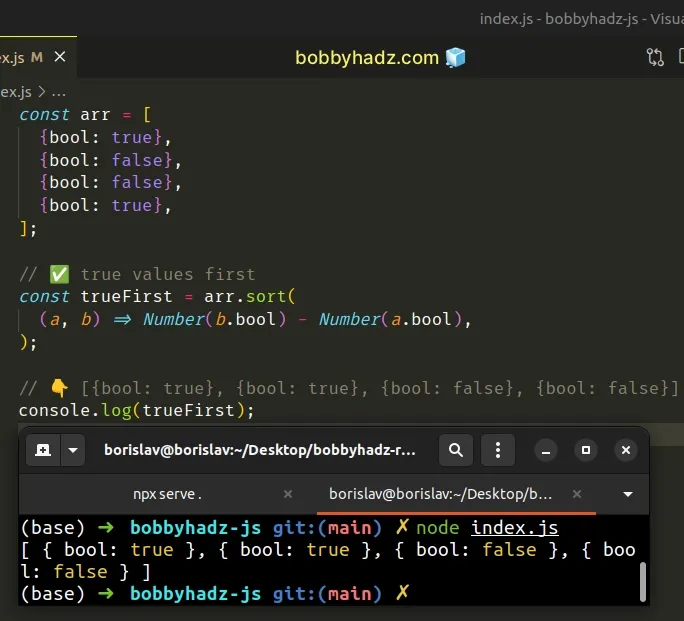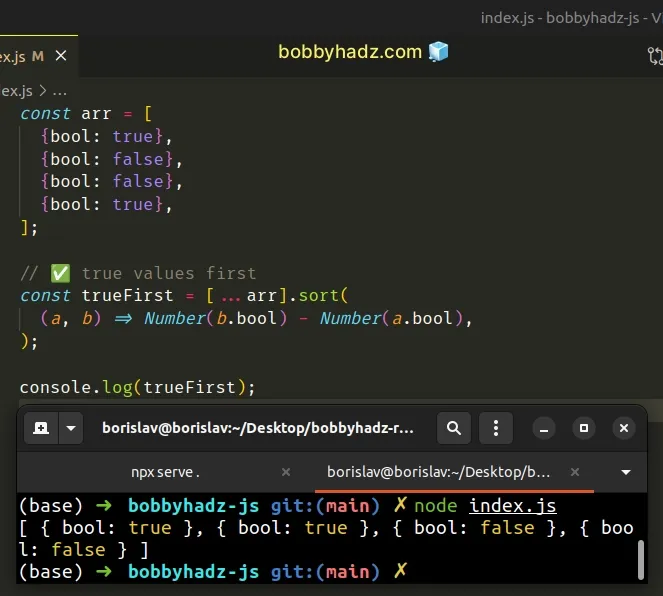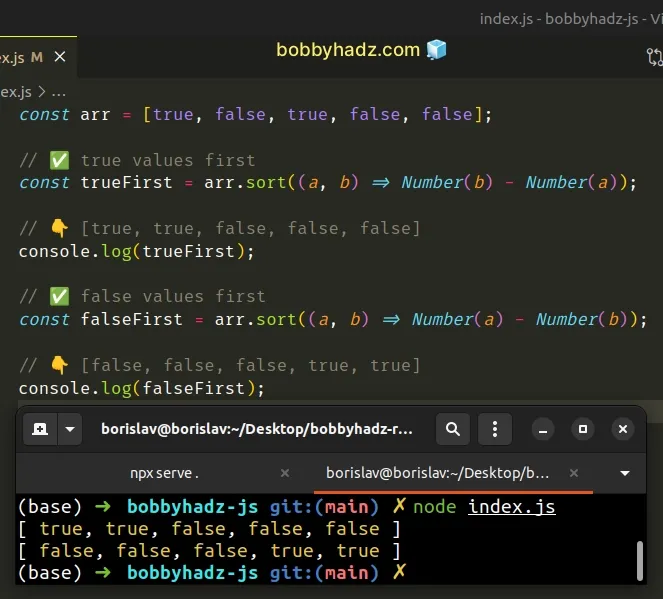Sort an Array of Objects by Boolean property in JavaScript
Last updated: Mar 6, 2024
Reading time·5 min

# Table of Contents
# Sort an Array of Objects by Boolean property in JavaScript
To sort an array of objects by a boolean property:
- Call the
sort()method on the array, passing it a function. - In the function, convert the 2 boolean values to numbers.
- Subtract the first number from the second.
- The
sortmethod will sort the array in place, by the boolean property.
const arr = [ {bool: true}, {bool: false}, {bool: false}, {bool: true}, ]; // ✅ true values first const trueFirst = arr.sort( (a, b) => Number(b.bool) - Number(a.bool), ); // 👇️ [{bool: true}, {bool: true}, {bool: false}, {bool: false}] console.log(trueFirst); // ------------------------------------------------------ // ✅ false values first const falseFirst = arr.sort( (a, b) => Number(a.bool) - Number(b.bool), ); // 👇️ [{bool: false}, {bool: false}, {bool: true}, {bool: true}] console.log(falseFirst);

We used the Array.sort() method to sort an array of objects by a boolean property.
sort() method sorts the elements of the array in place and returns the sorted array. In other words, it mutates the original array.const arr = [{bool: true}, {bool: false}, {bool: false}, {bool: true}]; // ✅ true values first const trueFirst = arr.sort((a, b) => Number(b.bool) - Number(a.bool)); // 👇️ [{bool: true}, {bool: true}, {bool: false}, {bool: false}] console.log(trueFirst); // 👇️ [{bool: true}, {bool: true}, {bool: false}, {bool: false}] // 👇️ (Original array also changed) console.log(arr);
# Sort an Array of Objects by Boolean property without mutation
If you want to sort the array without mutating it, use the spread syntax (...)
to create a shallow copy before calling the sort() method.
const arr = [ {bool: true}, {bool: false}, {bool: false}, {bool: true}, ]; // ✅ true values first const trueFirst = [...arr].sort( (a, b) => Number(b.bool) - Number(a.bool), ); // 👇️ [ { bool: true }, { bool: true }, { bool: false }, { bool: false } ] console.log(trueFirst); // ✅ false values first const falseFirst = [...arr].sort( (a, b) => Number(a.bool) - Number(b.bool), ); // 👇️ [ { bool: false }, { bool: false }, { bool: true }, { bool: true } ] console.log(falseFirst); // 👇️ [ { bool: true }, { bool: false }, { bool: false }, { bool: true } ] console.log(arr);

We used the
spread syntax (...) to
unpack the values of the array into a new array before calling the sort
method.
The sort() method takes a function that defines the sort order as a parameter.
const arr = [{bool: true}, {bool: false}, {bool: false}, {bool: true}]; // ✅ true values first const trueFirst = arr.sort((a, b) => Number(b.bool) - Number(a.bool)); // ✅ false values first const falseFirst = arr.sort((a, b) => Number(a.bool) - Number(b.bool));
The sort() method uses the following logic to sort the elements in the array:
If the return value of the compare function is greater than
0, then sortbbeforea.If the return value of the compare function is less than
0, then sortabeforeb.If the return value of the compare function is equal to
0, keep the original order ofaandb.
When converting booleans to a number, true gets converted to 1, and false
gets converted to 0.
console.log(Number(true)); // 👉️ 1 console.log(Number(false)); // 👉️ 0
In the true values first example:
- If subtracting
a.boolfromb.boolreturns1, thenbistrueandaisfalse, so we sortbbeforea. - If we get
-1, thenbisfalseandaistrue, so we sortbaftera. - If we get
0, we keep the original order ofaandb.
# Sort an Array of Booleans in JavaScript
To sort an array of booleans:
- Call the
sort()method on the array, passing it a function. - In the function, convert the 2 boolean values to numbers.
- Subtract the first number from the second.
const arr = [true, false, true, false, false]; // ✅ true values first const trueFirst = arr.sort((a, b) => Number(b) - Number(a)); // 👇️ [true, true, false, false, false] console.log(trueFirst); // ✅ false values first const falseFirst = arr.sort((a, b) => Number(a) - Number(b)); // 👇️ [false, false, false, true, true] console.log(falseFirst);

We used the Array.sort() method to sort an array of booleans.
sort() method sorts the elements of the array in place and returns the sorted array. In other words, it mutates the original array.const arr = [true, false, true, false, false]; // ✅ true values first const trueFirst = arr.sort((a, b) => Number(b) - Number(a)); // 👇️ [true, true, false, false, false] console.log(trueFirst); // 👇️ [true, true, false, false, false] // 👇️ Original array also changed console.log(arr);
If you want to sort the array without mutating it, use the spread syntax (...)
to create a shallow copy before calling the sort() method.
const arr = [true, false, true, false, false]; // ✅ true values first // 👇️ create shallow copy first const trueFirst = [...arr].sort((a, b) => Number(b) - Number(a));
We used the
spread syntax (...) to
unpack the values of the array into a new array before calling the sort
method.
The sort() method takes a function that defines the sort order as a parameter.
const arr = [true, false, true, false, false]; // ✅ true values first const trueFirst = arr.sort((a, b) => Number(b) - Number(a)); // ✅ false values first const falseFirst = arr.sort((a, b) => Number(a) - Number(b));
The sort() method uses the following logic to sort the elements in the array:
If the return value of the compare function is greater than
0, then sortbbeforea.If the return value of the compare function is less than
0, then sortabeforeb.If the return value of the compare function is equal to
0, keep the original order ofaandb.
When converting booleans to a number, we get 1 for true values and 0 for
false values.
console.log(Number(true)); // 👉️ 1 console.log(Number(false)); // 👉️ 0
In the true values first example:
- If subtracting
afrombreturns1, thenbistrueandaisfalse, so we sortbbeforea. - If we get
-1, thenbisfalseandaistrue, so we sortbaftera. - If we get
0, we keep the original order ofaandb.
const arr = [true, false, true, false, false]; // ✅ true values first const trueFirst = arr.sort((a, b) => Number(b) - Number(a));
# Additional Resources
You can learn more about the related topics by checking out the following tutorials:
- How to sort a Set in JavaScript
- Sort an Array of Objects by Date property in JavaScript
- Sort an Array of Strings in Descending order in JavaScript
- Sort an Array with NULL values coming last in JavaScript
- Sort an Array without Mutation using JavaScript
- Sort an Array of strings ignoring the Case in JavaScript
- How to sort a Map in JavaScript
- Sort the Keys of an Object in JavaScript

